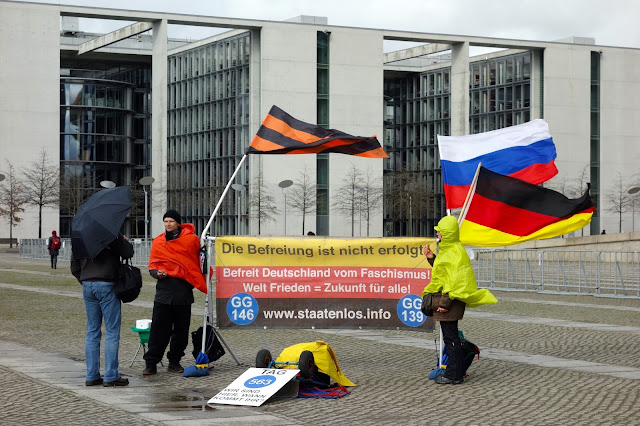Florian lives in Moabit, part of the former West Berlin, in a cheap apartment with a balcony near the Birkenstrasse U-Bahn stop. He pays just 380 euros a month, not including utilities.
Berlin scared me when I visited with my parents in 1962. My father put me on his shoulders near Checkpoint Charlie to get a glimpse over the Wall. I saw barbed wire, guards with rifles, rabbits and gray desolation. The bear population certainly has increased since then.
I like the traffic light guys even more.
You can find them on all kinds of merchandise, including beach towels and welcome mats, at this store. I bought a t-shirt.
Florian left me on my own while he went to his job as a physical therapist at a nearby rehabilitation hospital. I headed out on foot and spotted this sign near the central train station. It combines two of my favorite things in the world!
My walk took me across the Spree on a bridge guarded by griffins at both ends.
Bypassing several federal government buildings, I headed to the Tiergarten, an enormous park filled with incredible statues.
Many of the statues commemorate Germany's cultural contributions to music and literature.
Some temporary, less appealing "art" bluntly addressed Germany's past.
There's a memorial to the homosexuals who were killed by the Nazis, too.
Here's what you see when you look through the opening. It's on a continuous loop.
Just across the street, off of Hannah Arendtstrasse, is the Memorial to the Murdered Jews of Europe. It wasn't there the last time I visited Berlin, 12 years ago.
Hundreds of gray concrete slabs are planted in the ground at uneven elevations creating a grid of cobblestoned alleys with nothing but the sky above.
The concept eluded me at first and I was more than a little shocked by the hilarity of children using the grid to play "hide and seek." After deciding their game wasn't a bad metaphor for the Jewish experience in Nazi Germany, I spent hours in the chilly drizzle trying to capture an iconic image, never realizing that an information center lies beneath the memorial.
This series, culminating in "shhhh," is my favorite.
From this angle, the memorial resembles a cemetery. More on the real things later. I'm obsessed.
There are plenty of other things to see near the memorial, including another one that honors the gypsies murdered by the Nazis.
German flags fly above the Reichstag in the distance.
In 2003, Dan and I climbed up to the top of the dome. When no one was looking, we thought it would be funny to raise our hands in a Nazi salute. Little did we know we could have been arrested for committing a criminal act.
Government dissatisfaction exists everywhere in the world.
Angela Merkel, the German Chancellor and most powerful woman in the world, can walk to the Reichstag from her office across the Spree.
During my last visit to Berlin, the Brandenburg Gate was under renovation and wrapped in a giant advertisement for an internet company.
The new American Embassy is a stone's throw away.
Before re-unification, most East Germans with cars drove Trabants, or "Trabbis." Although everybody makes fun of them today, that hasn't stopped tourism companies from offering Berlin safaris in colorfully painted models. You can pedal a bicycle almost as fast.
I walked from Brandenburg Gate to the Victory Column or Siegessaulle along the Street of June 17, the western half of a huge boulevard that has seen a lot of history. Paved since the end of the 18th century, Berliners celebrated Germany's declaration of war in August 1914 here. Nazis lined the magnificent boulevard, bordered here by the Tiergarten on both sides, with flags during military parades. Allied air forces landed on it after they defeated Hitler.
Everyone deserted the viewing platform when a storm blew in.
Berliners call the woman at the top Golden Lizzy. She lived up to her nickname in the late afternoon sunlight, my first of the trip.
The walk back to Florian's took me past several butch statues and Bellevue, the German White House.
Moabit, on the other side of the Spree, looked serenely beautiful. Graffiti is as unavoidable in Berlin as it was in New York during the 70s.
Cheap rents caused a youth quake in east Berlin after re-unification. But now, gentrification is occurring in parts of west Berlin that have been overlooked since the Wall fell. You know something's up when the art galleries start moving in.
Florian told me to look for the tall church steeple to help me find my way back to his apartment. This lion was fiercer than any I had seen in Kenya last fall. I'll bet he would have enjoyed some of the currywurst we had for dinner.
More Germany With Florian









































































